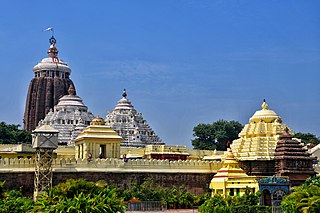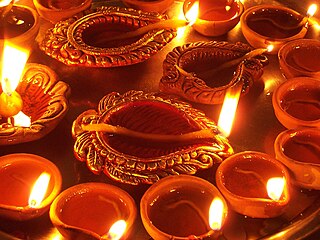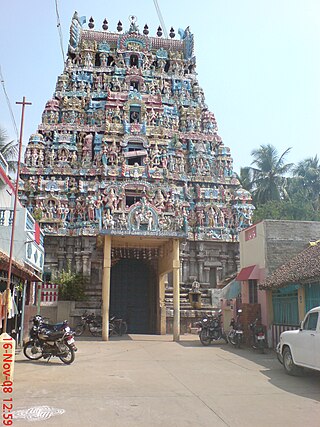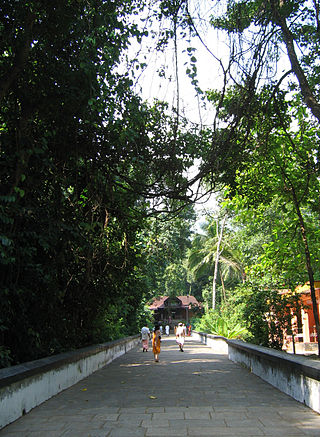
Bhrigu was a rishi in Hinduism. He was one of the seven great sages, the Saptarshis, one of the many Prajapatis created by Brahma. The first compiler of predictive astrology, and also the author of Bhrigu Samhita, the astrological (Jyotish) classic, Bhrigu is considered a Manasa Putra ("mind-born-son") of Brahma. The adjectival form of the name, Bhargava, is used to refer to the descendants and the school of Bhrigu. According to Manusmriti, Bhrigu was a compatriot of and lived during the time of Manu, the Hindu progenitor of humanity. Bhrigu had his Ashram (Hermitage) on the Vadhusar River, a tributary of the Drishadwati River near Dhosi Hill in the Vedic state of Brahmavarta, presently on the border of Haryana and Rajasthan in India. Along with Manu, Bhrigu had made important contributions to Manusmriti, which was constituted out of a sermon to a congregation of saints in the state of Brahmavarta, after the great floods in this area. As per Skanda Purana, Bhrigu migrated to Bhrigukutch, modern Bharuch on the banks of the Narmada river in Gujarat, leaving his son Chyavana at Dhosi Hill.

Puja is a worship ritual performed by Hindus, Buddhists and Jains to offer devotional homage and prayer to one or more deities, to host and honor a guest, or to spiritually celebrate an event. It may honor or celebrate the presence of special guests, or their memories after they die. The word pūjā is Sanskrit, and means reverence, honor, homage, adoration, and worship. Puja, the loving offering of light, flowers, and water or food to the divine, is the essential ritual of Hinduism. For the worshipper, the divine is visible in the image, and the divinity sees the worshipper. The interaction between human and deity, between human and guru, is called darshan, seeing.

Saraswati is the Hindu goddess of knowledge, music, art, speech, wisdom, and learning. She is one of the Tridevi, along with the goddesses Lakshmi and Parvati.

Omkareshwar is a Hindu temple dedicated to Shiva, located in Mandhata, nearby Khandwa city in Khandwa district of the Indian state of Madhya Pradesh. It is one of the 12 revered Jyotirlinga shrines of Shiva. centuries ago the Bhil tribe settled people on this place and now this place is famous for its grandeur and history. It is on an island called Mandhata, near Khandwa city in the Narmada river at Khandwa district in Madhya Pradesh, India; the shape of the island is said to be like the Devanagari ॐ symbol.

A Shankha has religious ritual importance in Hinduism. It is the shell of any suitable sea snail which had a hole made for the performer's embouchure.

Ganga is the personification of the river Ganges, who is worshipped by Hindus as the goddess of purification and forgiveness. Known by many names, Ganga is often depicted as a fair, beautiful woman, riding a divine crocodile-like creature called the makara. Some of the earliest mentions of Ganga are found in the Rigveda, where she is mentioned as the holiest of the rivers. Her stories mainly appear in post-Vedic texts such as the Ramayana, Mahabharata, and the Puranas.

Badarinath or Badarinarayana Temple is a Hindu temple dedicated to Vishnu. It is situated in the town of Badrinath in Uttarakhand, India. The temple is also one of the 108 Divya Desams dedicated to Vishnu—holy shrines for Vaishnavas—who is worshipped as Badrinath. It is open for six months every year, because of extreme weather conditions in the Himalayan region. The temple is located in Garhwal hill tracks in Chamoli district along the banks of Alaknanda River. It is one of the most visited pilgrimage centers of India, having recorded 2.8 million visits in just 2 months in 2022. It is one of the Char Dham pilgrimage sites.

Hara Saabha Vimochana Perumal Temple in Thirukandiyur, a village in the outskirts of Thiruvayaru in the South Indian state of Tamil Nadu, is dedicated to the Hindu god Vishnu. Constructed in the Dravidian style of architecture, the temple is glorified in the Nalayira Divya Prabandham, the early medieval Tamil canon of the Alvar saints from the 6th–9th centuries CE. It is one of the 108 Divya Desam dedicated to Vishnu, who is worshipped as Hara Saabha Vimochana Perumal and his consort Lakshmi as Kamalavalli Nachiyar.

Suryanar Kovil is a Hindu temple dedicated to the deity Hindu Sun-God, located in Suryanar Kovil, a village near the South Indian town of Kumbakonam Thanjavur District in Tamil Nadu, India. The presiding deity is Suriyanar, the Sun and his consorts Ushadevi and Pratyusha Devi. The temple also has separate shrines for the other eight planetary deities. The temple is considered one of the nine Navagraha temples in Tamil Nadu. The temple is one of the few historic temples dedicated to Sun god and is also the only temple in Tamil Nadu which has shrines for all the planetary deities.

Pradosha or Pradosham is a bimonthly occasion on the thirteenth day of every fortnight in the Hindu calendar. It is closely connected with the worship of the Hindu god Shiva. The auspicious three-hour period 1.5 hours before and after sunset is considered as the most suited and optimal time for worship of Shiva on this day. The fasting vow performed during the period is called "Pradosha vrata". A devotee should wear rudraksha, Vibhuti and worship Shiva by abhisheka, sandal paste, bael leaves, fragrance, deepa and naivedya.

Banalinga, a stone found in nature, in the bed of the Narmada river in Madhya Pradesh state, India, is an iconic symbol of worship, based on either the scriptures or cultural traditions among the Hindus, particularly of the Shaivaites and Smartha Brahmins. Stones are ancient and connote divinity. It is a smooth ellipsoid stone.

The Sri Sita Ramachandraswamy temple is a Hindu temple dedicated to Rama, a prominent avatar of the god Vishnu. It is located on the banks of the Godavari River in the town of Bhadrachalam in east Telangana, India. Often simply referred to as Bhadrachalam or Bhadradri, the temple is considered one of the Divya Kshetrams of Godavari and is also revered as Dakshina Ayodhya.

The Char Dham, also rendered the Chatur Dhama is a set of four pilgrimage sites in India. It is believed that visiting these sites helps achieve moksha (salvation). The four Dhams are Badrinath, Dwarka, Jagannath and Rameswaram. It is believed that every Hindu should visit the Char Dhams during one's lifetime. The Char Dham as defined by Adi Shankara consists of four Hindu pilgrimage sites. These main 'dhamas' are the shrines of Vishnu and Rameshwaram is a shrine of Shiva. All the 'dhamas' are related to four epochs,(1) Dham of Satyuga- Badrinath, Uttarakhand (2) Dham of Tretayuga -Rameswaram, Tamil Nadu (3) Dham of Dwaparayuga - Dvaraka, Gujarat (4) Dham of Kaliyuga - Jagannatha Puri, Odisha.

Panch Prayag is an expression in Hindu religious ethos, specifically used to connote the five sacred river confluences in the Garhwal Himalayas in the state of Uttarakhand, India. The five prayags - prayag meaning "place of confluence of rivers" in Sanskrit - also termed as "Prayag pentad" are Vishnuprayag, Nandaprayag, Karnaprayag, Rudraprayag and Devprayag, in the descending flow sequence of their occurrence.

Worship in Hinduism is an act of religious devotion usually directed to one or more Hindu deities. A sense of Bhakti or devotional love is generally invoked. This term is probably a central one in Hinduism, but a direct translation from the Sanskrit to English is difficult. Worship takes a multitude of forms depending on geography and language. Worship is not confined to any place of worship, and it will often incorporate personal reflection, music, dance and poetry. Hindus usually perform worship in temples or at home to achieve some specific end or to integrate the body, mind and spirit. The aim is to live a pure life in order to help the performer reincarnate into a higher being.

Kasi Viswanathar Temple, Kumbakonam is a Hindu temple dedicated to Lord Shiva, located in Kumbakonam, Tamil Nadu, India. Here, Lord Shiva is worshipped as Kasi Viswanathar, and His consort Parvati is depicted as Visalakshi. The presiding deity is revered in the 7th-century Tamil Saiva canonical work, the Tevaram, written by Tamil saint poets known as the nayanars and classified as Paadal Petra Sthalam.

The Gajendra Varadha Perumal Temple in Thirukkavithalam, a village in the outskirts of Papanasam in the South Indian state of Tamil Nadu, is dedicated to the Hindu god Vishnu. Constructed in the Dravidian style of architecture, the temple is glorified in the Nalayira Divya Prabandham, the early medieval Tamil canon of the Alvar saints from the 6th–9th centuries CE. It is one of the 108 Divya Desams dedicated to Vishnu, who is worshipped as Gajendra Varadha Perumal and his consort Lakshmi as Ramamanivalli. The temple is one of the five Pancha-Kannan temples, where Krishna, an avatar of Vishnu is given prominence over the presiding deity.

Kottiyoor Temple is a prominent Shiva temple in Kottiyoor, Kannur, Kerala, India. Vadakkeshwaram Temple is the common name of the temple from ancient times, but some of the local people address the temple as Ikkare Kottiyoor as it is on the bank of the river close to the Kottiyoor village, to differentiate it from the shrine in the other side of the river. Thruchherumana Kshetram is also another name by which temple is known. The temple is a special category temple under Malabar Devaswom board.

Panathur is a major town in Vellarikundu Taluk of Kasaragod district in Kerala State, India. It belongs to Kanhangad legislative constituency. Its population is about 12,000. It lies 1 km away from Kerala - Karnataka border, 42 km away from the nearest municipality, Kanhangad and 53 km away from the district headquarters, Kasaragod. It is surrounded from three sides by forest reserves and cashew plantations. Kudumbur River flows adjacent to the town.
Rang Panchami is a Hindu festival celebrated on Phalguna Krushnapaksha Panchami, that is the fifth day of the second fortnight of the month of Phalguna.




















